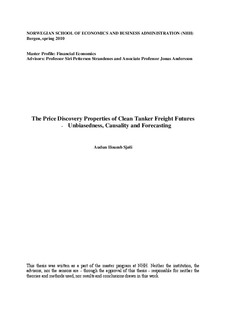The price discovery properties of clean tanker freight futures : unbiasedness, causality and forecasting
Master thesis
Permanent lenke
http://hdl.handle.net/11250/168655Utgivelsesdato
2010Metadata
Vis full innførselSamlinger
- Master Thesis [4372]
Sammendrag
The scope of this thesis is to examine the price discovery properties of clean tanker freight
futures. This is conducted by testing the unbiasedness hypothesis, the lead-lag relationship
between freight futures and spot rates and the forecasting properties of freight futures with
regards to the underlying spot rates. The research focuses on the most liquid clean tanker freight
futures, which are those written on the routes TC2, TC4 and TC5. The results indicate that
unbiasedness depends on the route in question and time to maturity. For a one-month horizon of
TC2 and one-, two- and three-month horizons of TC5, the unbiasedness hypothesis is found to
hold. Unbiasedness is also indicated for the two- and three-month horizons of TC2, but due to
weak evidence no conclusions are drawn. For TC4 the unbiasedness hypothesis is rejected. The
results from testing the lead-lag relationship indicate that futures prices lead spot rates for all the
routes, but the relationship is found to be bi-directional for TC4. When investigating the
forecasting performance of end-of-month freight futures it is found that univariate models
generally are outperformed by a random walk, indicating that forecasts should not be based on
historic spot prices alone. The multivariate models confirm this finding as they generally produce
more accurate forecasts than their univariate cousins. Multivariate time-series models were
generally found able to outperform forecasts indicated by outright futures prices for one- and
two-month horizons, but for a three-month horizon the futures performed as well as or better
than the multivariate models. These results imply that the investigated freight futures contain
valuable information about future spot rates. Problems regarding the stationarity of the series
were experienced throughout the thesis. Because of this it is recommended that the tests
performed in this thesis are repeated in a few years when more data is available.
